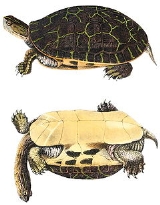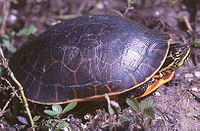
Chicken Turtle
Encyclopedia
The Chicken turtle is a cold-blooded uncommon freshwater turtle
found in the southeast of the United States
.
It is in the monotypic genus
Deirochelys.
The name "Chicken" turtle refers to the taste of their meat, which used to be popular in southern markets.
(Chrysemys picta picta), but have an unusually long, striped neck that is close to the length of the shell, with a yellow stripe on both the forelegs and rear legs. It has a distinguishable net-like pattern on its carapace
. The carapace is pear-shaped, and is an olive to dark brown. Females are usually larger than the males, and males have a longer, thicker tail. Males also have longer front claws. At birth, Chicken turtles are one inch in diameter, and adults reach from 10.2-25.4 cm. They are medium in size compared to other turtles.
s or seeking areas to burrow into the soil
and escape dry conditions. Males generally travel around farther than females. They are social, spending much of their time basking on logs and rocks and swim in small groups. Chicken turtles hibernate in the soft mud, but only in the northern part of their range, and vegetation of bodies of water. They are known to be timid and if caught they generally will bite very easily.
 Chicken turtles, made up of three subspecies, are found in suitable habitat throughout the southeastern United States. Deirochelys reticularia is found in the coastal areas of Virginia to Texas and northward Oklahoma
Chicken turtles, made up of three subspecies, are found in suitable habitat throughout the southeastern United States. Deirochelys reticularia is found in the coastal areas of Virginia to Texas and northward Oklahoma
and Arkansas
. The Florida subspecies, D. r. chrysea, is limited to peninsular Florida. The Eastern, D. r. reticularia, and Western, D. r. miaria, subspecies of chicken turtles are separated by Mississippi River
. It is a basking turtle, and is often found wandering far from water.
s and lakes, ditches, marshes, cypress swamps, and Carolina Bays. They prefer water with dense vegetation and soft substrate. Chicken turtles are tolerant of ephemeral aquatic habitats and readily travel onto land to burrow into the soil and escape dry conditions. They've been found at depths of a few centimeters to more than 2 m.
. Once the female is receptive, copulation occurs. Chicken turtles are different from most other North American turtles because they nest in either fall or winter. In South Carolina, there are two-egg laying seasons; from winter to early spring (February to may) and fall to early winter (August to November). Females excavate cylindrical nest on land in a variety of soil types, from sandy to heavy soils. Females lay 2 to 19 clutches of eggs. Chicken turtle embryos go through a period of dispause in the late gastrula stage. They must experience a period of cool temperatures before development proceeds. Eggs hatch in 152 days at 29 Celsius, some eggs may overwinter in the nest before hatching. Incubation temperature influences the sex of the embryos, with a 25 degrees Celsius incubation temperature resulting in all males. Warmer temperatures result in an increase in female embryos, with only 11 percent becoming males at incubation temperatures of 30 degrees Celsius.
+
, eating crayfish
, fish
, fruits, insect
s, invertebrates, frogs, tadpole
s and plants. During the first year of their life they are almost completely carnivorous. As though they are mostly carnivorous at birth they will still eat plants.
Chicken turtles use their well-developed hyoid apparatus to create suction that pulls food items into their throat, its very unique.
Turtle
Turtles are reptiles of the order Testudines , characterised by a special bony or cartilaginous shell developed from their ribs that acts as a shield...
found in the southeast of the United States
United States
The United States of America is a federal constitutional republic comprising fifty states and a federal district...
.
It is in the monotypic genus
Genus
In biology, a genus is a low-level taxonomic rank used in the biological classification of living and fossil organisms, which is an example of definition by genus and differentia...
Deirochelys.
The name "Chicken" turtle refers to the taste of their meat, which used to be popular in southern markets.
Description
They are similar in appearance to the eastern painted turtlePainted Turtle
The painted turtle is the most widespread native turtle of North America. It lives in slow-moving fresh waters, from southern Canada to Louisiana and northern Mexico, and from the Atlantic to the Pacific. The turtle is the only species of the genus Chrysemys, which is part of the pond turtle...
(Chrysemys picta picta), but have an unusually long, striped neck that is close to the length of the shell, with a yellow stripe on both the forelegs and rear legs. It has a distinguishable net-like pattern on its carapace
Carapace
A carapace is a dorsal section of the exoskeleton or shell in a number of animal groups, including arthropods such as crustaceans and arachnids, as well as vertebrates such as turtles and tortoises. In turtles and tortoises, the underside is called the plastron.-Crustaceans:In crustaceans, the...
. The carapace is pear-shaped, and is an olive to dark brown. Females are usually larger than the males, and males have a longer, thicker tail. Males also have longer front claws. At birth, Chicken turtles are one inch in diameter, and adults reach from 10.2-25.4 cm. They are medium in size compared to other turtles.
Behavior
Chicken turtles are regularly encountered on land, migrating between aquatic habitatHabitat
* Habitat , a place where a species lives and grows*Human habitat, a place where humans live, work or play** Space habitat, a space station intended as a permanent settlement...
s or seeking areas to burrow into the soil
Soil
Soil is a natural body consisting of layers of mineral constituents of variable thicknesses, which differ from the parent materials in their morphological, physical, chemical, and mineralogical characteristics...
and escape dry conditions. Males generally travel around farther than females. They are social, spending much of their time basking on logs and rocks and swim in small groups. Chicken turtles hibernate in the soft mud, but only in the northern part of their range, and vegetation of bodies of water. They are known to be timid and if caught they generally will bite very easily.
Lifespan
Wild chicken turtles have been recaptured up to 15 years old after their first capture. Some reached the maximum ages of 20 to 24 years.Range

Oklahoma
Oklahoma is a state located in the South Central region of the United States of America. With an estimated 3,751,351 residents as of the 2010 census and a land area of 68,667 square miles , Oklahoma is the 28th most populous and 20th-largest state...
and Arkansas
Arkansas
Arkansas is a state located in the southern region of the United States. Its name is an Algonquian name of the Quapaw Indians. Arkansas shares borders with six states , and its eastern border is largely defined by the Mississippi River...
. The Florida subspecies, D. r. chrysea, is limited to peninsular Florida. The Eastern, D. r. reticularia, and Western, D. r. miaria, subspecies of chicken turtles are separated by Mississippi River
Mississippi River
The Mississippi River is the largest river system in North America. Flowing entirely in the United States, this river rises in western Minnesota and meanders slowly southwards for to the Mississippi River Delta at the Gulf of Mexico. With its many tributaries, the Mississippi's watershed drains...
. It is a basking turtle, and is often found wandering far from water.
Habitat
Chicken turtles are semi-aquatic turtles, found both in water and on land. They prefer quiet still bodies of water: Shallow pondPond
A pond is a body of standing water, either natural or man-made, that is usually smaller than a lake. A wide variety of man-made bodies of water are classified as ponds, including water gardens, water features and koi ponds; all designed for aesthetic ornamentation as landscape or architectural...
s and lakes, ditches, marshes, cypress swamps, and Carolina Bays. They prefer water with dense vegetation and soft substrate. Chicken turtles are tolerant of ephemeral aquatic habitats and readily travel onto land to burrow into the soil and escape dry conditions. They've been found at depths of a few centimeters to more than 2 m.
Reproduction
Males reproduce with female chicken turtles by vibrating the fore-claws against the female's faceFace
The face is a central sense organ complex, for those animals that have one, normally on the ventral surface of the head, and can, depending on the definition in the human case, include the hair, forehead, eyebrow, eyelashes, eyes, nose, ears, cheeks, mouth, lips, philtrum, temple, teeth, skin, and...
. Once the female is receptive, copulation occurs. Chicken turtles are different from most other North American turtles because they nest in either fall or winter. In South Carolina, there are two-egg laying seasons; from winter to early spring (February to may) and fall to early winter (August to November). Females excavate cylindrical nest on land in a variety of soil types, from sandy to heavy soils. Females lay 2 to 19 clutches of eggs. Chicken turtle embryos go through a period of dispause in the late gastrula stage. They must experience a period of cool temperatures before development proceeds. Eggs hatch in 152 days at 29 Celsius, some eggs may overwinter in the nest before hatching. Incubation temperature influences the sex of the embryos, with a 25 degrees Celsius incubation temperature resulting in all males. Warmer temperatures result in an increase in female embryos, with only 11 percent becoming males at incubation temperatures of 30 degrees Celsius.
+
Diet
Chicken Turtles are omnivorousOmnivore
Omnivores are species that eat both plants and animals as their primary food source...
, eating crayfish
Crayfish
Crayfish, crawfish, or crawdads – members of the superfamilies Astacoidea and Parastacoidea – are freshwater crustaceans resembling small lobsters, to which they are related...
, fish
Fish
Fish are a paraphyletic group of organisms that consist of all gill-bearing aquatic vertebrate animals that lack limbs with digits. Included in this definition are the living hagfish, lampreys, and cartilaginous and bony fish, as well as various extinct related groups...
, fruits, insect
Insect
Insects are a class of living creatures within the arthropods that have a chitinous exoskeleton, a three-part body , three pairs of jointed legs, compound eyes, and two antennae...
s, invertebrates, frogs, tadpole
Tadpole
A tadpole or polliwog is the wholly aquatic larval stage in the life cycle of an amphibian, particularly that of a frog or toad.- Appellation :...
s and plants. During the first year of their life they are almost completely carnivorous. As though they are mostly carnivorous at birth they will still eat plants.
Chicken turtles use their well-developed hyoid apparatus to create suction that pulls food items into their throat, its very unique.
Conservation status
Chicken turtle populations are currently considered stable throughout their range, although they do face potential threats. The eastern chicken turtle species is listed as state threatened in Virginia. Habitat destruction reduces suitable habitat for foraging, migration, and hibernation. Chicken turtles are sometimes killed on roads as they migrate between habitats. Hunting for food impacts populations of chicken turtles as well.Subspecies
There are three distinct sub-species of Chicken turtle:- Eastern chicken turtle (Deirochelys reticularia reticularia)
- Florida chicken turtle (Deirochelys reticularia chrysea)
- Western chicken turtleWestern Chicken TurtleThe western chicken turtle is a small to medium-sized aquatic turtle.- Description :The egg-shaped carapace is rough textured without keels or marginal serrations and tends to be olive to brown in color. The vertebral scutes are broad, the first of which connects to four marginal and the cervical...
(Deirochelys reticularia miaria)

